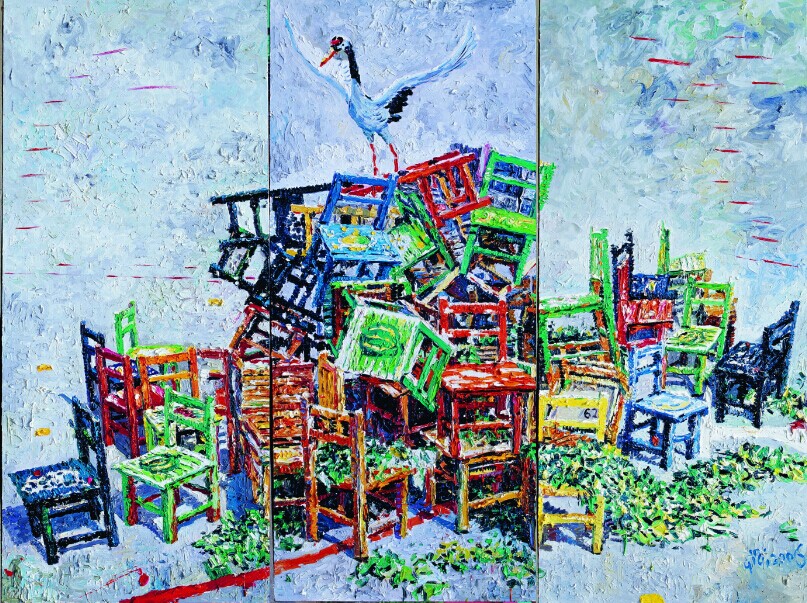
Great changes have taken place in China's contemporary ideology since 1990s, in terms of problems, art has been changed from the discussion platform for political problem of aesthetics to the platform of thinking and discussion of culture in the international political and economic context. Artistic creation has become the process for artists to “think with their visions”, the insight and thinking of artists, the views of artists to think about the world, the ideas of artists for the world and social attitude, and the activities to combine life practice with art. It is the mentality of the new generation of Chinese artists to re-perceive, discover and understand this world with the sharp perception of the art after the old patterns gradually collapsed and broke up.
In the eyes of the artists of the same generation with Qin Qi who was born in mid 1970s, painting no longer possesses the nature of eternal myth, in this field, all the “haloes” that established the self-elevation for the artists have been destroyed by mechanical copying and image myth. How do we use painting which has independent traditional language to get innovation from art history, image prototype and art inertia? How do we think and face the reality we have experienced. Whether the realities expressed by artists are the “sceneries” in the eyes of passengers, or the “living world” of common people? Can the painting really face real life, and convey the living condition buried deep inside. We are facing an existing world seemingly certain, but full of absurdities, a non-aesthetic living world, a hard reality, a ruin full of energy, and that is the information conveyed by the paintings of Qin Qi. How to reflect the contemporary nature of multi-culture and get rid of the real circumstances of the painting problems? Can painting become a thinking “installation” for us to think and understand the world, become a pacifier to get rid of the obsolete old life and language fatigue or a tool of resistance? What to relieve with painting—all the fatigue our bodies endure, everything paintings express become the symbol to listen to the physical things and resistance of human bodies? What to resist with the painting—all the erosions our bodies bear? In the face of the swiftly approaching hackneyed expression of consumerism and artistic consumption, what can artists do is to refer to the state of mind? It is still early to say how Qin Qi, as a young artist, has made innovative work for the painting, but we may see the attitude of an artist to resist all the things by reading his works and seeing his progress. In this attitude, we can see the significance of persistence in the painting.
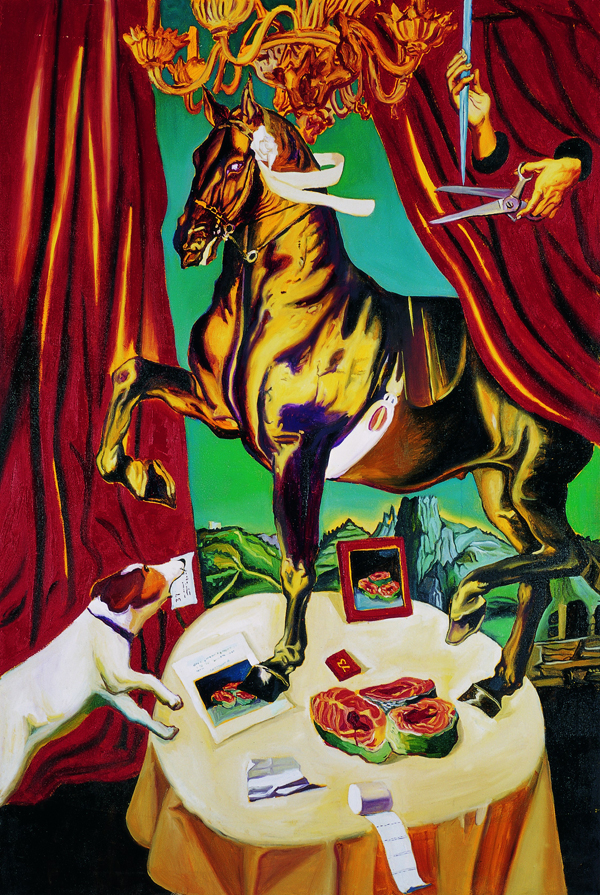
A Horse Fond of Performance, Oil on Canvas, 180 x 160cm, 1998
Qin Qi received his education and mind training in mid 1990s when he was a post graduate of painting in Luxun Academy of Fine Arts. Great pattern changes of the time were the important scenes of the society—like the “post-revolutionary” scenes of Tiexi District, a documentary directed by Wang Bing to depict the dramatic social changes in North-Eastern China in late 1990s—the reality of avalanche collapse from public to daily life, a class died in this era. The inevitable fall of the industry in North-Eastern China, once China's important strategic industrial base, means the end of history when socialist planned economy undertook economic accumulation for the country and self-development, and it also means the end of a time. The main part of “post-revolution”—the main part after socialist revolution, the Cultural Revolution and the post-cultural revolution—consists of the margin of capital history and the remnant of socialism. This subject position can hold the disdain capital and the sarcasm of socialism simultaneously. It does not only provide the dialectical viewpoint to criticize and realize the past of socialism, but also provide the imagination “object” for those grown up in capital history, a space to imagine another history. In such mind growing context, the artist, on the one hand, pre-set the main trend created by the dominant state as the discussing field and tried to make his voice here, on the other hand, artistic work usually focused on the aesthetics and trendology, turned art into a discussion field for self-contained artists. But we can not avoid a key problem during our choice: the creation of art is sure to be closely connected with political issues and social reality. Right in this contemporary context, and in the face of so many different accumu lated experiences, art made up of motley and diversity of thinking by heterogeneities.
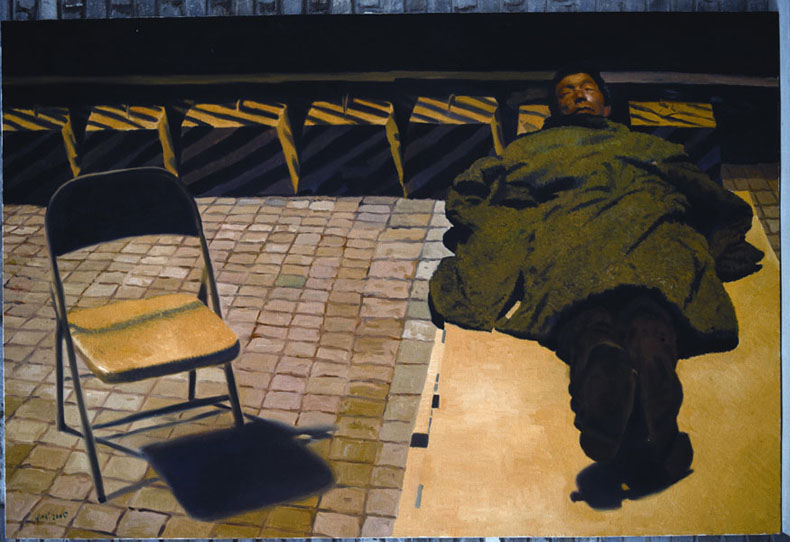
We Can Sit in The Chair But Not Lie in It, Oil on Canvas, 160 x 200cm, 2005
In the visual creation of diversity, the consciousness of the artist was to get rid of the rule of reproducibility of some ideology first (in the orientation of aesthetics), such as the annotation of the great history of Chinese Art in 1980s, the identification with the great principal, the extremization of political stance, and discussion of roles etc. During that time, “miniature”—“ macro-politics” came into being in the field of art, satisfying such stance of evasion or rather rebellion without falling to another reappearance of “magnitude”. In addition to the qualitative change of the size itself, micromation enhanced the link between the relationships with the environment. It was right this contextual connection that turned the artistic activity into a thinking project, and made the artistic writing of “macro-politics” with complex profound significance: it did not provide a world with size and existing status, but also made some individual activities to have the “surpassing” possibilities. Art was no longer the show or performance of the attitude, but itself became the radical topic of ontology or epistemology. At that time, Yan Lei, Wang Xingwei, Zhou Tiehai, Wang Yin and Ding Yi etc. had deep suspicion over the technique and gusto of the painting, they started to reflect on and reject the danger of instrumentalization, they tried to make innovations in the aspects of concepts and functions of the painting through various of painting experiments.
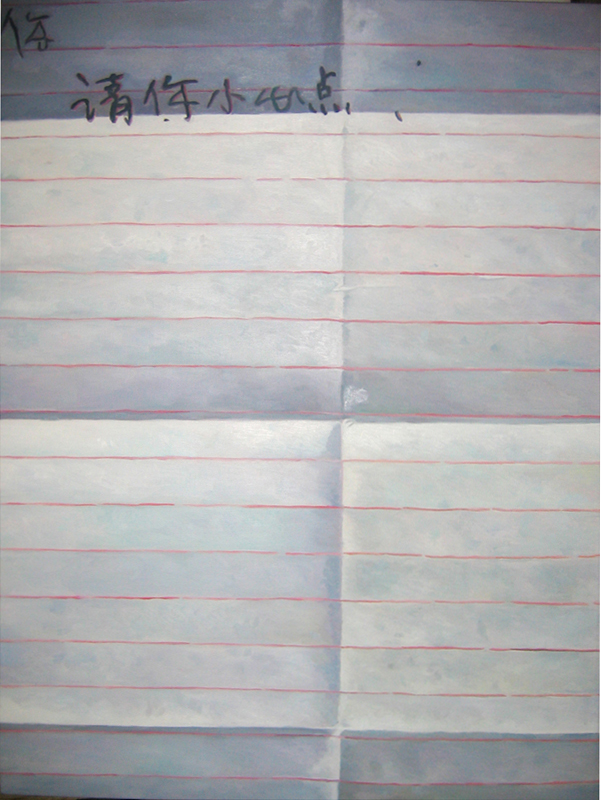
Please Be A Little More Careful, Oil on canvas, 100X80cm, 2004
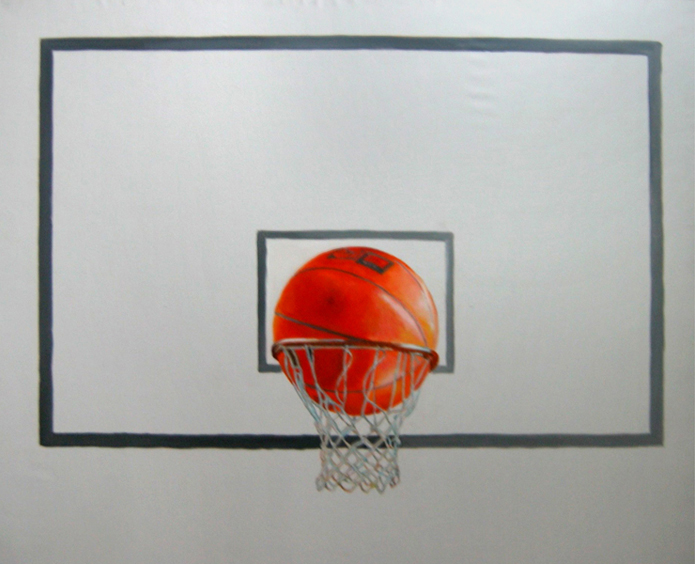
Basketball, Oil on Canvas, 180 x 220cm, 2004
Qin Qi graduated from Luxun Academy of Fine Arts in 2002 when his graduation painting received attention. A horse jumps to a table from behind the curtain in the painting Horse Felling for Performance, the hands reached out by the “magician” make the stage absurd, all these seem to be both reasonable and unreasonable. The keen sense, courage and ability unique to the artist drew the attention. Among all the works of Qin Qi, the early ones have a kind of surreal sense, violent scenes snarled in the atmosphere of the time. In his early painting of 7th Road West, a youngster is lurking behind a wall with a brick in hand, as if he is expecting the coming of his target. In the Son of the Boss, the hooligan-like kids in school uniforms are onlooking the fighting. Qin Qi reflected the bored emotion of the youngsters of that time with dramatic and local grassroot humor. Then, he quickly started another painting experiment, he created a subtle link between the text and the picture. In the Chairs can Save Lives—chair series, he realized the possibility of expression with regard to chairs through changes of the meaning of picture for the word “chair”. In the works of Captain and Shabby Crane, form, language and the fictive plots create a new picture order, becoming a structure which seems to have an intrinsic text relationship. This expressional structure was used repeatedly in his recent series of painting. Observing Qin Qi's creation, we are not certain about his creative work though, we can see his rejection, this attitude also means mature and self-reflection. He refused to degrade painting to narrative language. He started to separate the experiences of painting history or art history from the diversified experienced through non-subject of persons, then put these restructured experiences together with the absurdity of the reality to create plots for the fiction, and hide the grammatical structure deeper and deeper. He refused to put definite labels on the things he painted. Qin Qi repeatedly depicted the things that could not “reappear” in the painting or the layout, and saved them from the familiar context through reconfiguration of concepts. All kinds of narration derived from their relationship, and the effects in perception, sensibility and senses made the problem of “what could be painted” invalid, and unsensible. Qin Qi also rejected any uniformed space and opinion, he conceived a hidden problem consciousness through rewriting and intervention of different reality materials. He constantly made changes, and placed the thinking of reality to a thinking framework of consciousness through the methods of still life, landscape, sketch from nature and painting realistically.
In all the problems rejected by Qin Qi, we find that while he is reflecting and surpassing the established painting language, he is exploring the multi-possibilities for the painting—embedding contemporary thinking to the disputed painting for the possibilities to let painting hold penetration of power and superposition of information again, to let the sharp observation of time parameter connect with history and memory through “present”, to change or invent new images in destroying the historical images of the past paintings. For artists, this may mean that art does not pursue the so-called absolute truth, but rather cares the rediscovery and thinking of the reality, and the exploration of possibilities of freedom of human spirit.How to place art with traditional language energy to the contemporary context for thinking and creation is the significance of young artists from Minsheng Art Museum to make serial introductions of Qin Qi's paintings.
